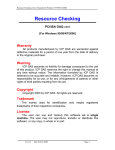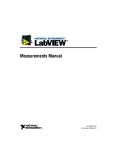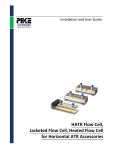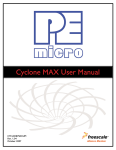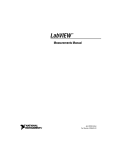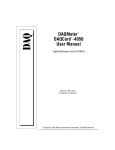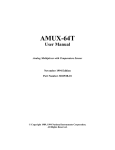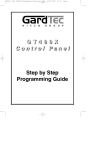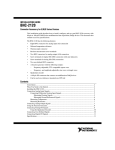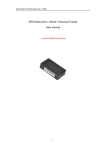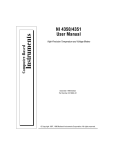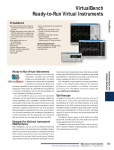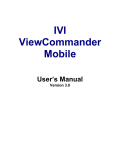Download Getting Started with VirtualBench
Transcript
Getting Started with VirtualBench Getting Started with VirtualBench January 2000 Edition Part Number 321518E-01 Worldwide Technical Support and Product Information www.ni.com National Instruments Corporate Headquarters 11500 North Mopac Expressway Austin, Texas 78759-3504 USA Tel: 512 794 0100 Worldwide Offices Australia 03 9879 5166, Austria 0662 45 79 90 0, Belgium 02 757 00 20, Brazil 011 284 5011, Canada (Calgary) 403 274 9391, Canada (Ontario) 905 785 0085, Canada (Québec) 514 694 8521, China 0755 3904939, Denmark 45 76 26 00, Finland 09 725 725 11, France 01 48 14 24 24, Germany 089 741 31 30, Greece 30 1 42 96 427, Hong Kong 2645 3186, India 91805275406, Israel 03 6120092, Italy 02 413091, Japan 03 5472 2970, Korea 02 596 7456, Mexico (D.F.) 5 280 7625, Mexico (Monterrey) 8 357 7695, Netherlands 0348 433466, New Zealand 09 914 0488, Norway 32 27 73 00, Poland 0 22 528 94 06, Portugal 351 1 726 9011, Singapore 2265886, Spain 91 640 0085, Sweden 08 587 895 00, Switzerland 056 200 51 51, Taiwan 02 2528 7227, United Kingdom 01635 523545 For further support information, see the Technical Support Resources appendix. To comment on the documentation, send e-mail to [email protected] © Copyright 1997, 2000 National Instruments Corporation. All rights reserved. Important Information Warranty The media on which you receive National Instruments software are warranted not to fail to execute programming instructions, due to defects in materials and workmanship, for a period of 90 days from date of shipment, as evidenced by receipts or other documentation. National Instruments will, at its option, repair or replace software media that do not execute programming instructions if National Instruments receives notice of such defects during the warranty period. National Instruments does not warrant that the operation of the software shall be uninterrupted or error free. A Return Material Authorization (RMA) number must be obtained from the factory and clearly marked on the outside of the package before any equipment will be accepted for warranty work. National Instruments will pay the shipping costs of returning to the owner parts which are covered by warranty. National Instruments believes that the information in this document is accurate. The document has been carefully reviewed for technical accuracy. In the event that technical or typographical errors exist, National Instruments reserves the right to make changes to subsequent editions of this document without prior notice to holders of this edition. The reader should consult National Instruments if errors are suspected. In no event shall National Instruments be liable for any damages arising out of or related to this document or the information contained in it. EXCEPT AS SPECIFIED HEREIN, NATIONAL INSTRUMENTS MAKES NO WARRANTIES, EXPRESS OR IMPLIED, AND SPECIFICALLY DISCLAIMS ANY WARRANTY OF MERCHANTABILITY OR FITNESS FOR A PARTICULAR PURPOSE. CUSTOMER’S RIGHT TO RECOVER DAMAGES CAUSED BY FAULT OR NEGLIGENCE ON THE PART OF NATIONAL INSTRUMENTS SHALL BE LIMITED TO THE AMOUNT THERETOFORE PAID BY THE CUSTOMER. NATIONAL INSTRUMENTS WILL NOT BE LIABLE FOR DAMAGES RESULTING FROM LOSS OF DATA, PROFITS, USE OF PRODUCTS, OR INCIDENTAL OR CONSEQUENTIAL DAMAGES, EVEN IF ADVISED OF THE POSSIBILITY THEREOF. This limitation of the liability of National Instruments will apply regardless of the form of action, whether in contract or tort, including negligence. Any action against National Instruments must be brought within one year after the cause of action accrues. National Instruments shall not be liable for any delay in performance due to causes beyond its reasonable control. The warranty provided herein does not cover damages, defects, malfunctions, or service failures caused by owner’s failure to follow the National Instruments installation, operation, or maintenance instructions; owner’s modification of the product; owner’s abuse, misuse, or negligent acts; and power failure or surges, fire, flood, accident, actions of third parties, or other events outside reasonable control. Copyright Under the copyright laws, this publication may not be reproduced or transmitted in any form, electronic or mechanical, including photocopying, recording, storing in an information retrieval system, or translating, in whole or in part, without the prior written consent of National Instruments Corporation. Trademarks DAQCard™, DAQMeter™, National Instruments™, ni.com™, NI-DAQ™, SCXI™, and VirtualBench™ are trademarks of National Instruments Corporation. Product and company names mentioned herein are trademarks or trade names of their respective companies. WARNING REGARDING USE OF NATIONAL INSTRUMENTS PRODUCTS (1) NATIONAL INSTRUMENTS PRODUCTS ARE NOT DESIGNED WITH COMPONENTS AND TESTING FOR A LEVEL OF RELIABILITY SUITABLE FOR USE IN OR IN CONNECTION WITH SURGICAL IMPLANTS OR AS CRITICAL COMPONENTS IN ANY LIFE SUPPORT SYSTEMS WHOSE FAILURE TO PERFORM CAN REASONABLY BE EXPECTED TO CAUSE SIGNIFICANT INJURY TO A HUMAN. (2) IN ANY APPLICATION, INCLUDING THE ABOVE, RELIABILITY OF OPERATION OF THE SOFTWARE PRODUCTS CAN BE IMPAIRED BY ADVERSE FACTORS, INCLUDING BUT NOT LIMITED TO FLUCTUATIONS IN ELECTRICAL POWER SUPPLY, COMPUTER HARDWARE MALFUNCTIONS, COMPUTER OPERATING SYSTEM SOFTWARE FITNESS, FITNESS OF COMPILERS AND DEVELOPMENT SOFTWARE USED TO DEVELOP AN APPLICATION, INSTALLATION ERRORS, SOFTWARE AND HARDWARE COMPATIBILITY PROBLEMS, MALFUNCTIONS OR FAILURES OF ELECTRONIC MONITORING OR CONTROL DEVICES, TRANSIENT FAILURES OF ELECTRONIC SYSTEMS (HARDWARE AND/OR SOFTWARE), UNANTICIPATED USES OR MISUSES, OR ERRORS ON THE PART OF THE USER OR APPLICATIONS DESIGNER (ADVERSE FACTORS SUCH AS THESE ARE HEREAFTER COLLECTIVELY TERMED “SYSTEM FAILURES”). ANY APPLICATION WHERE A SYSTEM FAILURE WOULD CREATE A RISK OF HARM TO PROPERTY OR PERSONS (INCLUDING THE RISK OF BODILY INJURY AND DEATH) SHOULD NOT BE RELIANT SOLELY UPON ONE FORM OF ELECTRONIC SYSTEM DUE TO THE RISK OF SYSTEM FAILURE. TO AVOID DAMAGE, INJURY, OR DEATH, THE USER OR APPLICATION DESIGNER MUST TAKE REASONABLY PRUDENT STEPS TO PROTECT AGAINST SYSTEM FAILURES, INCLUDING BUT NOT LIMITED TO BACK-UP OR SHUT DOWN MECHANISMS. BECAUSE EACH END-USER SYSTEM IS CUSTOMIZED AND DIFFERS FROM NATIONAL INSTRUMENTS' TESTING PLATFORMS AND BECAUSE A USER OR APPLICATION DESIGNER MAY USE NATIONAL INSTRUMENTS PRODUCTS IN COMBINATION WITH OTHER PRODUCTS IN A MANNER NOT EVALUATED OR CONTEMPLATED BY NATIONAL INSTRUMENTS, THE USER OR APPLICATION DESIGNER IS ULTIMATELY RESPONSIBLE FOR VERIFYING AND VALIDATING THE SUITABILITY OF NATIONAL INSTRUMENTS PRODUCTS WHENEVER NATIONAL INSTRUMENTS PRODUCTS ARE INCORPORATED IN A SYSTEM OR APPLICATION, INCLUDING, WITHOUT LIMITATION, THE APPROPRIATE DESIGN, PROCESS AND SAFETY LEVEL OF SUCH SYSTEM OR APPLICATION. Conventions The following conventions appear in this manual: » The » symbol leads you through nested menu items and dialog box options to a final action. The sequence File»Page Setup»Options directs you to pull down the File menu, select the Page Setup item, and select Options from the last dialog box. This icon denotes a note, which alerts you to important information. bold Bold text denotes items that you must select or click on in the software, such as menu items and dialog box options. Bold text also denotes parameter names. italic Italic text denotes variables, emphasis, a cross reference, or an introduction to a key concept. This font also denotes text that is a placeholder for a word or value that you must supply. monospace Text in this font denotes text or characters that you should enter from the keyboard, sections of code, programming examples, and syntax examples. This font is also used for the proper names of disk drives, paths, directories, programs, subprograms, subroutines, device names, functions, operations, variables, filenames and extensions, and code excerpts. monospace bold Bold text in this font denotes the messages and responses that the computer automatically prints to the screen. This font also emphasizes lines of code that are different from the other examples. monospace italic Italic text in this font denotes text that is a placeholder for a word or value that you must supply. Contents Chapter 1 Welcome to VirtualBench Minimum System Requirements ...................................................................................1-1 Installing VirtualBench..................................................................................................1-2 What the Setup Program Installs ...................................................................................1-2 Installing on a Network..................................................................................................1-3 Connecting Signals to Your Data Acquisition Device ..................................................1-3 Chapter 2 VirtualBench-Scope Launching VirtualBench-Scope.....................................................................................2-1 Front Panel Features ......................................................................................................2-1 Acquiring Data...............................................................................................................2-4 Chapter 3 VirtualBench-DSA Launching VirtualBench-DSA ......................................................................................3-1 Front Panel Features ......................................................................................................3-1 Acquiring and Measuring Signals..................................................................................3-3 Chapter 4 VirtualBench-Logger Launching VirtualBench-Logger ...................................................................................4-1 Front Panel Features ......................................................................................................4-2 Acquiring Data...............................................................................................................4-3 Chapter 5 VirtualBench-FG Launching VirtualBench-FG .........................................................................................5-1 Front Panel Features ......................................................................................................5-1 Generating a Waveform.................................................................................................5-2 © National Instruments Corporation v Getting Started with VirtualBench Contents Chapter 6 VirtualBench-DMM Launching VirtualBench-DMM .................................................................................... 6-1 Front Panel Features ...................................................................................................... 6-1 Measuring a Signal ........................................................................................................ 6-3 Chapter 7 VirtualBench-Power Supply Launching VirtualBench-Power Supply........................................................................ 7-1 Front Panel Features ...................................................................................................... 7-1 Turning on the Power Supply........................................................................................ 7-3 Chapter 8 VirtualBench-Switch Launching VirtualBench-Switch ................................................................................... 8-1 Front Panel Features ...................................................................................................... 8-1 Making Connections...................................................................................................... 8-3 Chapter 9 VirtualBench-Arb and VirtualBench-Waveform Editor Launching VirtualBench-Arb........................................................................................ 9-1 Waveform Generator Front Panel Features................................................................... 9-1 Generating a Waveform ................................................................................................ 9-2 Creating a New Waveform............................................................................................ 9-4 Waveform Editor Front Panel Features......................................................................... 9-6 Chapter 10 VirtualBench-Device Calibrator Launching VirtualBench-Device Calibrator.................................................................. 10-1 Front Panel Features ...................................................................................................... 10-1 Calibrating a DAQ Device ............................................................................................ 10-2 Chapter 11 VirtualBench-Counter Launching VirtualBench-Counter ................................................................................. 11-1 Front Panel Features ...................................................................................................... 11-1 Measuring a Signal ........................................................................................................ 11-3 Getting Started with VirtualBench vi www.ni.com Contents Chapter 12 VirtualBench-Logic Analyzer Launching VirtualBench-Logic Analyzer .....................................................................12-1 Front Panel Features ......................................................................................................12-1 Acquiring Data...............................................................................................................12 -4 Appendix A Technical Support Resources Figures Figure 2-1. Figure 2-2. Front Panel of VirtualBench-Scope ......................................................2-2 General Tab of VirtualBench-Scope Settings Dialog Box....................2-5 Figure 3-1. Figure 3-2. Figure 3-3. Figure 3-4. Front Panel of VirtualBench-DSA ........................................................3-2 Input Tab of DSA Input Settings Dialog Box .......................................3-3 Triggering Tab of DSA Input Settings Dialog Box ..............................3-4 Span Tab of DSA Frequency Settings Dialog Box ...............................3-5 Figure 4-1. Figure 4-2. Figure 4-3. Figure 4-4. Front Panel of VirtualBench-Logger.....................................................4-2 Logger Settings Dialog Box ..................................................................4-4 File Configuration Dialog Box..............................................................4-5 Timing Configuration Dialog Box ........................................................4-6 Figure 5-1. Figure 5-2. Front Panel of VirtualBench-FG ...........................................................5-1 VirtualBench-FG Settings Dialog Box..................................................5-3 Figure 6-1. Figure 6-2. Figure 6-3. Figure 6-4. Front Panel of VirtualBench-DMM ......................................................6-1 General Tab of VirtualBench-DMM Settings Dialog Box ...................6-3 Current and Resistance Tab of VirtualBench-DMM Settings Dialog Box ............................................................................................6-4 Temperature Tab of VirtualBench-DMM Settings Dialog Box............6-6 Figure 7-1. Figure 7-2. Figure 7-3. Figure 7-4. Front Panel of VirtualBench-Power Supply..........................................7-2 Power Supply Settings Configuration ...................................................7-3 Front Panel with Volts DC Button Selected..........................................7-4 Front Panel with Volts AC Button Selected..........................................7-5 Figure 8-1. Front Panel of VirtualBench-Switch .....................................................8-2 Figure 9-1. Figure 9-2. Figure 9-3. Front Panel of VirtualBench-Arb Waveform Generator .......................9-1 Channels Tab of VirtualBench-Arb Settings Dialog Box .....................9-3 Front Panel of VirtualBench-Arb Waveform Editor .............................9-6 © National Instruments Corporation vii Getting Started with VirtualBench Contents Figure 10-1. Front Panel of VirtualBench-Device Calibrator ................................... 10-1 Figure 11-1. Figure 11-2. Figure 11-3. Figure 11-4. Figure 11-5. Front Panel of VirtualBench-Counter. .................................................. 11-1 General Tab of VirtualBench-Counter Settings Dialog Box. ............... 11-3 Encoder Tab of VirtualBench-Counter Settings Dialog Box ............... 11-6 Time/Samples Tab of VirtualBench-Counter Settings Dialog Box ............................................................................................ 11-7 Filter Tab of VirtualBench-Counter Settings Dialog Box .................... 11-8 Figure 12-1. Figure 12-2. Figure 12-3. Front Panel of VirtualBench-Logic Analyzer....................................... 12-2 Settings of VirtualBench-Logic Analyzer. ........................................... 12-4 Bus Settings of VirtualBench-Logic Analyzer. .................................... 12-5 Getting Started with VirtualBench viii www.ni.com 1 Welcome to VirtualBench The VirtualBench suite of tools is a high-performance, easy-to-use virtual instruments application program for Windows NT/2000/98/95. This manual gives you step-by-step instructions on how to use each instrument. It also includes a description of the front panel of each instrument. This chapter lists the minimum system requirements for VirtualBench, explains how to install VirtualBench, and tells you what the setup program installs. Minimum System Requirements To run VirtualBench, you must have the following: • Microsoft Windows NT 4.0 or higher, Microsoft Windows 2000, Windows 98, or Windows 95 • Personal computer using at least a 66 MHz 486 or higher microprocessor with floating-point capability (National Instruments recommends a Pentium 60 or higher microprocessor with floating-point capability.) • VGA resolution (or higher) video adapter • Minimum of 32 MB of RAM • 40 MB free hard disk space • Microsoft-compatible mouse • NI-DAQ 6.7 or later © National Instruments Corporation 1-1 Getting Started with VirtualBench Chapter 1 Welcome to VirtualBench Installing VirtualBench You must install VirtualBench with NI-DAQ driver software. Note National Instruments recommends you close other applications before you install VirtualBench. Complete these steps to install VirtualBench: 1. Insert your VirtualBench Installation CD into your CD-ROM drive. 2. Wait several seconds. On most computers, the AutoRun utility on the CD automatically launches the VirtualBench Installation CD dialog box. 3. If the VirtualBench Installation CD dialog box does not appear, use the Start button in the Windows taskbar to select Run and type d:\setup in the input box, where d is your CD-ROM drive. Click OK. 4. Click Install VirtualBench in the VirtualBench Installation CD dialog box. Note Read the VirtualBench readme.txt file on the VirtualBench Installation CD for the latest information about installing and using VirtualBench. What the Setup Program Installs The VirtualBench setup program installs the following virtual instruments, with online help for each instrument: Getting Started with VirtualBench • Oscilloscope (Scope) • Dynamic signal analyzer (DSA) • Function generator (FG) • Logger • Arbitrary waveform generator (Arb) • Waveform editor (Arb) • Device calibrator (CAL) • Counter 1-2 www.ni.com Chapter 1 Welcome to VirtualBench Installing on a Network Contact National Instruments for licensing information if you plan to run VirtualBench on a network. Connecting Signals to Your Data Acquisition Device Refer to the user manual for your National Instruments DAQ device for instructions on connecting signals to your device. © National Instruments Corporation 1-3 Getting Started with VirtualBench 2 VirtualBench-Scope This chapter explains the VirtualBench-Scope (oscilloscope) front panel features and how to acquire data with the oscilloscope. Launching VirtualBench-Scope To launch VirtualBench-Scope, use the Start button in the Windows taskbar to select Programs»VirtualBench»VirtualBench-Scope. Front Panel Features This section explains the features of the VirtualBench-Scope front panel, shown in Figure 2-1. © National Instruments Corporation 2-1 Getting Started with VirtualBench Chapter 2 VirtualBench-Scope Maximize/Minimize Graphics Display Trigger Cursor Vertical Sliders Channel Selector Channel Settings Graphics Display Timebase Trigger Settings Group Zoom Controls Main Control Bar Figure 2-1. Front Panel of VirtualBench-Scope The front panel of VirtualBench-Scope has the following features: Getting Started with VirtualBench • Channel Selector—Selects a waveform for display on the graphics display. • Channel Settings – Channel—Selects the active channel. – Volts/div—Adjusts the vertical sensitivity of the active channel. – Coupling—Selects AC or DC input coupling. – V. Position—Moves the active channel vertically on the graph. • Timebase—Controls the timebase setting. Turning the knob clockwise reduces the time period that appears in the graphics display. Each horizontal division represents one time period. • Trigger Cursor—Changes the trigger level and position. Move the trigger cursor by clicking and dragging the cursor on the display. 2-2 www.ni.com Chapter 2 VirtualBench-Scope • Graphics Display—Displays waveforms, channel information, cursor, and waveform measurements. • Maximize/Minimize Graphics Display—Maximizes the graphics display so that it fills the entire window. • Vertical Sliders—Adjust voltage offset for each channel. Use a slider when you want to adjust multiple waveforms in the graphics display. • Trigger Settings Group—Controls the conditions required for signal acquisition; for example, whether to wait for a digital trigger before acquiring data or whether to acquire data in free-run mode (no triggering). • Main Control Bar Buttons • – Run—Acquires data continuously. Deselection of this button places the VirtualBench-Scope in idle mode. – Single—Instructs VirtualBench-Scope to perform a single acquisition. – Auto Setup—Configures the scope for the best timebase, volts per division, and trigger setting for each channel currently selected with the channel selector. – Mode—Sets the mode of the scope to volts versus time or X versus Y mode. – Select—Selects a subset of the waveform for further analysis or for saving to disk. Zoom Controls—Adjusts the view of your display data. – Scroll Bar—Adjusts zoom view. – Zoom In—Zooms in on display data. Each zoom increases the view by a factor of two. – Zoom Out—Zooms out to full X scale. Note Refer to the VirtualBench-Scope Online Reference for more information about the front panel items. © National Instruments Corporation 2-3 Getting Started with VirtualBench Chapter 2 VirtualBench-Scope Acquiring Data When you launch VirtualBench-Scope, it operates in continuous run mode. Complete the following steps to start acquiring signals with VirtualBench-Scope: 1. If you are using a DAQ device, connect a signal to the Channel 0 input of your device. Refer to the user manual of your DAQ device for details. For example, on a 68-pin MIO E-series device, connect a signal to pins 68 (ACH0) and 67 (AIGND) for a referenced single-ended input. If you are using an IVI device, connect a signal to the appropriate channel of your device. Refer to Chapter 4, Configuring Your System, in the IVI Driver Library User Manual for more information about configuring your IVI virtual instrument. 2. Getting Started with VirtualBench Configure VirtualBench-Scope. a. Select Edit»General Settings on the front panel. b. Select the National Instruments DAQ or IVI instrument you want to use from the Acquire tab of the Scope Settings dialog box, shown in Figure 2-2. If a device does not appear in the Instrument list, make sure you have properly configured the instrument using the Measurement & Automation Explorer or you have configured an IVIScope virtual instrument in the Measurement & Automation Explorer. Refer to Chapter 4, Configuring Your System, in the IVI Driver Library User Manual for more information about configuring your IVI virtual instrument. 2-4 www.ni.com Chapter 2 VirtualBench-Scope Figure 2-2. General Tab of VirtualBench-Scope Settings Dialog Box c. Click OK to use these settings. Note When you launch VirtualBench-Scope, it automatically uses the settings of your previous VirtualBench-Scope session. 3. Enable the button for the connected channel in the Channel Selector group. Disable all other channels. 4. To start, click Auto Setup on the main control bar. 5. To change the trigger position, drag the trigger cursor (the small green cursor in the center of the graph). 6. Click Run to stop the acquisition. Note Refer to the VirtualBench-Scope Online Reference for information about configuring VirtualBench-Scope for your specific application. © National Instruments Corporation 2-5 Getting Started with VirtualBench 3 VirtualBench-DSA This chapter explains the front panel features of the VirtualBench dynamic signal analyzer (DSA) and how to acquire and measure signals. Launching VirtualBench-DSA To launch VirtualBench-DSA, use the Start button in the Windows taskbar to select Programs»VirtualBench»VirtualBench-DSA. Front Panel Features This section explains the features of the VirtualBench-DSA front panel, shown in Figure 3-1. © National Instruments Corporation 3-1 Getting Started with VirtualBench Chapter 3 VirtualBench-DSA Display Settings Controls Display Settings Controls Measurement Displays Main Control Bar Figure 3-1. Front Panel of VirtualBench-DSA The front panel of VirtualBench-DSA has the following features: • Display Settings Controls—Provides individual control of the measurements VirtualBench-DSA performs on each display. You can select the channels, function, magnitude/phase mode, magnitude unit, log/linear mode, phase unit, and markers for a display. • Main Control Bar Buttons—Contains the Run, Single, and Pause controls. • – Run—Acquires data continuously. Deselecting this button places VirtualBench-DSA in idle mode. – Single—Acquires a single frame of data. – Pause—Pauses the acquisition. Pausing does not clear the averaging buffers. Measurement Displays—Displays measurements, reference waveforms, and markers for marker measurements. Note Refer to the VirtualBench-DSA Online Reference for more information about the front panel items. Getting Started with VirtualBench 3-2 www.ni.com Chapter 3 VirtualBench-DSA Acquiring and Measuring Signals Complete the following steps to start acquiring and measuring signals with VirtualBench-DSA: 1. Connect a signal to the Channel 0 or 1 input of your DAQ device. Refer to the user manual of your DAQ device for details. 2. Configure the DSA. a. Select Edit»Input Settings on the front panel. b. Select the Input tab from the DSA Settings dialog box, shown in Figure 3-2. Figure 3-2. Input Tab of DSA Input Settings Dialog Box c. © National Instruments Corporation Select the device you want to use for the data acquisition. The Device list displays only devices you have configured successfully in the Measurement & Automation Explorer. 3-3 Getting Started with VirtualBench Chapter 3 VirtualBench-DSA d. Click the Triggering tab in the DSA Settings dialog box, shown in Figure 3-3. Figure 3-3. Triggering Tab of DSA Input Settings Dialog Box Getting Started with VirtualBench e. Set the Trigger Type to none. This setting puts the acquisition in free-run mode. f. Click OK. g. Select Edit»Frequency Settings on the front panel. h. Select the Span tab in the Frequency Settings dialog box, shown in Figure 3-4. 3-4 www.ni.com Chapter 3 VirtualBench-DSA Figure 3-4. Span Tab of DSA Frequency Settings Dialog Box 3. Select a Baseband Span that is appropriate to the signal you are trying to measure. Click OK. 4. In the upper display on the front panel, select Time Waveform in the Waveform Type pop-up menu. Choose Linear Magnitude in the Scale pop-up menu. 5. Select Markers None in the Markers pop-up menu. 6. In the lower display on the front panel, select Power Spectrum in the Waveform Type pop-up menu. Choose Log Magnitude in the Scale pop-up menu. 7. Click the Single button. VirtualBench-DSA displays a single frame of data. If no data is visible, click the Autoscale Y-axis button (the button that contains a “Y” and up/down arrows) in the display control. Check your signal connections if data still does not appear. 8. Click Run. VirtualBench-DSA continuously acquires and displays frames of data. 9. Click Run again to stop acquisition. Note Refer to the VirtualBench-DSA Online Reference for more information about configuring VirtualBench-DSA for your specific application. © National Instruments Corporation 3-5 Getting Started with VirtualBench VirtualBench-Logger 4 This chapter explains the VirtualBench-Logger front panel features and how to acquire data with the logger. Launching VirtualBench-Logger To launch VirtualBench-Logger, use the Start button in the Windows taskbar to select Programs»VirtualBench»VirtualBench-Logger. © National Instruments Corporation 4-1 Getting Started with VirtualBench Chapter 4 VirtualBench-Logger Front Panel Features This section explains the features of the VirtualBench-Logger front panel, shown in Figure 4-1. Y Axis Select Control Strip Chart Display Status Display Legend Control Channel Select Acquire Data Controls Figure 4-1. Front Panel of VirtualBench-Logger The front panel of VirtualBench-Logger has the following features: Getting Started with VirtualBench • Strip Chart Display—Displays the logged data. • Y Axis Select Controls—Selects which channel’s Y scale to display on either the left or right Y-axis of the strip chart display. • Status Display—Shows the current time, start time, and stop time of the current data acquisition. • Channel Select Control—Selects which channels to display on the strip chart display. You can use the Labels/Values radio buttons below the channel select control to switch between the channel labels and the 4-2 www.ni.com Chapter 4 VirtualBench-Logger channel values. When you select Labels, you can click a label to change which channel the system displays on that plot. When you select Values, you can click the value to change the number of decimal places the system displays for that channel. • Legend Control—Changes the trace attributes of each display channel. Clicking a trace in the legend control displays a menu that allows you to make changes to the point style, line style, interpolation method, and color of the trace. • Acquire Data Controls—Contains Logging On/Off, Clear Chart, Start, Stop, and Pause controls. – Logging On/Off—Enables or disables logging data to disk when you run the instruments. – Clear Chart—Clears the strip chart display. Clicking this button does not affect the acquisition of data. – Start—Starts the acquisition of data and data logging when enabled using the current logger configuration. – Stop—Stops the acquisition of data and data logging when enabled. – Pause—Temporarily stops the flow of data to the strip chart and log file when enabled. Note Refer to the VirtualBench-Logger Online Reference for more information about the front panel items. Acquiring Data Complete these steps to start acquiring data with VirtualBench-Logger: 1. Connect several known voltage signals to the input channels of your DAQ device. Refer to the user manual of your DAQ device for details. National Instruments recommends you use known reference signals to verify proper operation of VirtualBench-Logger and your DAQ device. 2. Configure VirtualBench-Logger. © National Instruments Corporation a. Select Edit»Settings on the front panel. b. Select the device and SCXI module that you want to use in the Logger Settings dialog box, shown in Figure 4-2. VirtualBench-Logger disables the SCXI Module list when no SCXI modules are configured for the selected device. The Device list displays only devices you have configured successfully in the Measurement & Automation Explorer. 4-3 Getting Started with VirtualBench Chapter 4 VirtualBench-Logger Figure 4-2. Logger Settings Dialog Box Note The options on the Logger Settings dialog box vary slightly if you use an NI 435x Series board. Refer to the VirtualBench-Logger Online Reference for more information. c. Set the Start Channel and End Channel controls appropriately for the channels that you connected signals to in Step 1. d. Set the channel attributes for each channel from the start channel to the end channel. e. Getting Started with VirtualBench – Select 0-Md1 Ch0 in the textbox. – Select the Transducer. The six transducer measurement types are VDC, Thermocouple, RTD, Current, Thermistor, and Resistance. – Give each channel an appropriate Label for easy identification on the strip chart display. – Select a Range for the specified channel. Click the File Config button. In the File Configuration dialog box, shown in Figure 4-3, specify the name of the log file where VirtualBench-Logger stores the logged data on disk. To specify 4-4 www.ni.com Chapter 4 VirtualBench-Logger the location of this file, use the Browse button. Select Enable Logging and Begin Logging on Start. Click OK. Note If you have not previously specified a log file, VirtualBench-Logger automatically displays a Save as dialog box. Figure 4-3. File Configuration Dialog Box f. © National Instruments Corporation Click the Timing Config button. In the Timing Configuration dialog box, as shown in Figure 4-4. Set the Start Timing and Stop Timing to start and stop manually. Set the Time Interval control to 1.00 seconds. Set Log to Disk Every n Time Intervals to 1. Set the Display Length to 1 minute. Click OK. 4-5 Getting Started with VirtualBench Chapter 4 VirtualBench-Logger Figure 4-4. Timing Configuration Dialog Box g. Click OK in the Logger Settings dialog box to return to the front panel. Note Refer to the VirtualBench-Logger Online Reference for more information about configuring VirtualBench-Logger for your specific application. Getting Started with VirtualBench 3. Select the channels you want to display on the strip chart using the channel select control. 4. Click the right or left Y-axis controls to select which channel’s Y-scale you want to display on the strip chart. 5. Click Start in the acquire data controls area. VirtualBench-Logger begins acquiring and logging data to disk at 1-second intervals and displays it on the strip chart. If no data appears, check the signal connections to your DAQ device or check the Range limits for the channels you selected in the Logger Settings dialog box. 6. Click the Stop button to stop the acquisition. 4-6 www.ni.com 5 VirtualBench-FG This chapter explains the VirtualBench function generator (FG) front panel features and how to generate a waveform. Launching VirtualBench-FG To launch VirtualBench-FG, use the Start button in the Windows taskbar to select Programs»VirtualBench»VirtualBench-FG. Front Panel Features This section explains the features of the VirtualBench-FG front panel, as shown in Figure 5-1. Display Window On Play Step List Range Selector Frequency Knob Function Selector Waveform Modifier Controls Figure 5-1. Front Panel of VirtualBench-FG © National Instruments Corporation 5-1 Getting Started with VirtualBench Chapter 5 VirtualBench-FG The front panel of VirtualBench-FG has the following features: • Display Window—Shows the actual waveform frequency VirtualBench-FG generates. • Range Selector—Selects the frequency range of VirtualBench-FG. • Function Selector—Selects which type of waveform VirtualBench-FG generates. • Frequency Knob—Controls the frequency of the waveform within the range you specify with the range selector. • Waveform Modifier Controls—Modifies some of the properties of the waveform. – Duty Cycle—Adjusts the duty cycles of the sine wave, square wave, and triangle wave. – Offset—Adjusts the DC offset of the waveform. – Amplitude—Adjusts the peak amplitude of the generated waveform. • On—Starts or stops waveform generation. • Play List—Outputs waveforms as specified in the frequency list. The Play List button appears only with 54xx devices. • Step—Steps through the frequency list. The Step button appears only with 54xx devices. Note Refer to the VirtualBench-FG Online Reference for more information about the front panel items. Generating a Waveform Complete the following steps to configure VirtualBench-FG to generate a waveform: 1. Getting Started with VirtualBench Configure the output. a. Select Edit»Settings on the front panel. b. Select the instrument you want to use for waveform generation in the VirtualBench-FG Settings dialog box, as shown in Figure 5-2. The Instrument list displays only devices that you have configured successfully in the Measurement & Automation Explorer. Refer to Chapter 4, Configuring Your System, in the IVI Driver Library User Manual for more information about configuring your IVI virtual instrument. 5-2 www.ni.com Chapter 5 VirtualBench-FG Figure 5-2. VirtualBench-FG Settings Dialog Box c. Set the Channel, Update Rate, Use FIFO, and Buffer Size controls. d. Click OK. 2. Connect a device or scope to the output of the analog output device that you specified in Step 1. Refer to your DAQ device user manual or instrument manual for details. 3. Click On. VirtualBench-FG continuously generates an analog waveform at the output pin. 4. Click On again to stop the waveform generation. Note Refer to the VirtualBench-FG Online Reference for more information about configuring VirtualBench-FG for your specific application. © National Instruments Corporation 5-3 Getting Started with VirtualBench 6 VirtualBench-DMM This chapter explains the VirtualBench digital multimeter (DMM) and how to measure a signal with the DMM. Launching VirtualBench-DMM To launch VirtualBench-DMM, use the Start button in the Windows taskbar to select Programs»VirtualBench»VirtualBench-DMM. Front Panel Features This section explains the features of the VirtualBench-DMM front panel, shown in Figure 6-1. Range Selector Volts AC Measurement Display Current Ohms Diode AC Volts Current 4-Wire Temperature DC DC Ohms Resolution Control Math Buttons Main Controls Figure 6-1. Front Panel of VirtualBench-DMM © National Instruments Corporation 6-1 Getting Started with VirtualBench Chapter 6 VirtualBench-DMM The front panel of VirtualBench-DMM has the following features: • Measurement Display—Displays measurements. • Function Selector—Selects which measurement mode you want to use. The modes, from left to right, are as follows: – Volts AC—Measures the AC component of a voltage signal. – Volts DC—Measures the DC component of a voltage signal. – Current AC—Measures the AC component of a current source. – Current DC—Measures the DC component of a current source. – Ohms—Measures resistance. – 4-Wire Ohms—Measures resistance using four-wire method. – Diode—Measures the voltage drop across a diode. – Temperature—Measures temperature. • Resolution Control—Selects the number of digits of resolution. • Range Selector—Determines the measurement range. This range is different for each measurement mode. AutoRange mode selects the best range to fit the input signal. • Main Control Buttons • – Run—Starts or stops the DMM acquisition. – Single—Acquires a single measurement. – Log—Enables logging. Math Control Buttons – Null—Selects relative mode. When you click this button, all subsequent measurements become relative to the measurement made when you pressed this button. – Max/Min—Displays the maximum and minimum values since you first clicked the button. – mX+B—Manipulates normal display readings (X) according to the calculation mX+B. – dB—Displays the decibel value of your signal. – dBm—Displays the decibel power level with respect to 1 mW. – %—Displays the current value as a percentage of a reference. Note Refer to the VirtualBench-DMM Online Reference for more information about the front panel items. Getting Started with VirtualBench 6-2 www.ni.com Chapter 6 VirtualBench-DMM Measuring a Signal Complete the following steps to start measuring signals with VirtualBench-DMM: 1. Configure VirtualBench-DMM. a. Select Edit»Settings on the front panel. b. Select the General tab, shown in Figure 6-2. Figure 6-2. General Tab of VirtualBench-DMM Settings Dialog Box 2. c. Select the instrument you want to use. VirtualBench-DMM hides the SCXI Module list when no SCXI modules are configured for the selected device. The Instrument list displays only devices you have configured successfully in the Measurement & Automation Explorer. Refer to Chapter 4, Configuring Your System, in the IVI Driver Library User Manual for more information about configuring your IVI virtual instrument. d. Set the channel to the source of your signal. e. Click OK. Measure voltage. VirtualBench-DMM measures AC and DC voltage without any external hardware. a. © National Instruments Corporation Connect a signal to the channel input that you specified in Step 1. Refer to the user manual of your DAQ device for details. 6-3 Getting Started with VirtualBench Chapter 6 VirtualBench-DMM 3. b. Click the Volts AC or Volts DC button in the Function selector. VirtualBench-DMM continuously acquires and displays voltage measurements in the display window. c. If the DMM display shows +CLIP or –CLIP, confirm the input signal does not exceed the range of your DAQ device and the input signal does not exceed the selected range. d. Click Run to stop the measurement. Measure current. If you are using an NI 4060 PCI/PXI-based multimeter or an IVI instrument, skip to Step 3g. If you are using any other device, VirtualBench-DMM requires a precision external shunt resistor to measure current. Complete these steps to configure your precision external shunt: a. Connect a precision shunt resistor across the input of the channel you specified in Step 1. Refer to the user manual of your DAQ device for details. b. Connect your current signal to the same terminals. c. Select Edit»Settings on the front panel. d. Select the Current and Resistance tab, shown in Figure 6-3. Figure 6-3. Current and Resistance Tab of VirtualBench-DMM Settings Dialog Box Getting Started with VirtualBench 6-4 www.ni.com Chapter 6 4. VirtualBench-DMM e. Enter the value of the shunt resistor in the Current Shunt Resistor control. f. Click OK. g. Click the Current AC or Current DC button in the Function selector, depending on which type of voltage you connected. h. Click Run. VirtualBench-DMM continuously acquires and displays current measurements in the display window. i. If the DMM display shows +CLIP or –CLIP, confirm the input signal does not exceed the range of your DAQ device or IVI instrument and the input signal does not exceed the selected range. j. Click Run again to stop the measurement. Measure resistance. If you are using an NI 4060 PCI/PXI-based multimeter, a DAQMeter DAQCard-4050, or an IVI device, skip to Step 4g. If you are using any other device, you must use a precision external current source to measure resistance. Complete these steps to configure your current source: © National Instruments Corporation a. Connect a precision current source to the channel you specified in Step 1. Refer to the user manual of your DAQ device for details. b. Connect the resistor you want to measure across the same terminals. c. Select Edit»Settings on the front panel. d. Select the Current and Resistance tab. e. Enter the value of the current source in the Current Source control. f. Click OK. g. Click the Ohms button in the Function selector. h. Click Run. VirtualBench-DMM continuously acquires and displays resistance measurements in the display window. i. If the DMM display shows +CLIP or –CLIP, confirm the input signal does not exceed the range of your DAQ device or IVI instrument and the input signal does not exceed the selected range. j. Click Run again to stop the measurement. 6-5 Getting Started with VirtualBench Chapter 6 VirtualBench-DMM 5. Measure temperature. VirtualBench-DMM requires a thermistor, IC sensor, or thermocouple to make precise temperature measurements. Because DAQMeter DAQCard-4050 or NI 4060 PCI/PXI-based multimeter does not support making temperature measurements, you cannot use VirtualBench-DMM to make temperature measurements for these boards. a. Connect a precision temperature sensor to the channel you specified in Step 1. Refer to the user manual of your DAQ device for details. b. Select Edit»Settings on the front panel. c. Select the Temperature tab, shown in Figure 6-4. Figure 6-4. Temperature Tab of VirtualBench-DMM Settings Dialog Box Getting Started with VirtualBench d. Select the type of sensor from the Temperature Sensor list you connected to the channel specified in Step 1a. e. Select the Temperature Units you want for the temperature display. f. Select the cold junction sensor type from the TC Cold Junction Source list when you use a thermocouple. Select the channel to which the cold junction sensor is connected. g. Click OK. h. Click the Temperature button in the Function selector. 6-6 www.ni.com Chapter 6 6. VirtualBench-DMM i. Click Run. VirtualBench-DMM continuously acquires and displays temperature measurements in the display window. j. If the DMM display shows +CLIP or –CLIP, confirm the input signal does not exceed the range of your DAQ device and the input signal does not exceed the selected range. k. Click Run again to stop the measurement. Measure a diode. If you are using a DAQMeter DAQCard-4050 or an NI 4060 PCI/PXI-based multimeter, you can measure the voltage drop across a diode, up to 2 V. If you are using an IVI instrument, you can also measure diode voltage if the instrument supports this. a. Connect the diode to the terminals of the DAQCard-4050 or NI 4060 PCI/PXI-based multimeter. b. Click the Diode button in the Function selector. c. Click Run. d. Click Run again to stop the measurement. Note Refer to the VirtualBench-DMM Online Reference for more information about configuring VirtualBench-DMM for your specific application. © National Instruments Corporation 6-7 Getting Started with VirtualBench 7 VirtualBench-Power Supply This chapter explains the front panel features of the VirtualBench-Power Supply and how to turn on VirtualBench-Power Supply. Launching VirtualBench-Power Supply To launch VirtualBench-Power Supply, use the Start button in the Windows task bar to select Programs»VirtualBench» VirtualBench-Power Supply. Note VirtualBench-Power Supply is for use only with IVI instruments. Front Panel Features This section describes the VirtualBench-Power Supply front panel. © National Instruments Corporation 7-1 Getting Started with VirtualBench Chapter 7 VirtualBench-Power Supply Over-Voltage Protection Graphics Display Over-Current Protection Volts DC Button Limits Button Volts AC Button Output On/Off Button Apply Button Figure 7-1. Front Panel of VirtualBench-Power Supply The front panel of VirtualBench-Power Supply has the following features: Getting Started with VirtualBench • Graphics Display—Shows real-time voltage and current measurements if your instrument supports these measurements. If your device does not support these measurements, the display shows your current settings. OVP indicates the over-voltage protection circuitry has tripped. OCP indicates the over-current protection circuitry has tripped. • Volts DC—Allows you to set the power supply to a specified DC voltage. • Volts AC—Allows you to set the power supply to a specified AC voltage, with optional settings such as waveform shape, frequency, amplitude, DC offset, and start phase. • Limits—Allows you to specify upper and lower voltage limits and a current limit, and enable over-voltage or over-current protection circuitry. • Apply—Commits changes you have made to front panel controls. • Output On/Off—Enables output of the Power Supply. 7-2 www.ni.com Chapter 7 VirtualBench-Power Supply Note Refer to the VirtualBench-Power Supply Online Reference for more information about the front panel items. Turning on the Power Supply When you launch VirtualBench-Power Supply, it always launches in a power off state. Complete the following steps to configure VirtualBench-Power Supply before using it: 1. Connect a load to one of the output channels of your power supply. 2. Configure VirtualBench-Power Supply. a. Select Edit»Settings on the front panel. b. Select the IVI instrument logical name you want to use. If you have not already configured a logical name for your instrument, VirtualBench-Power Supply has already created one for you with the same name as the virtual instrument installed in your system. Refer to Chapter 4, Configuring Your System, of the IVI Driver Library User Manual for more information about changing items to which another item refers. c. Select the channel you want to use, as shown in Figure 7-2. Figure 7-2. Power Supply Settings Configuration d. © National Instruments Corporation Click OK to use these settings. 7-3 Getting Started with VirtualBench Chapter 7 VirtualBench-Power Supply Complete these steps to generate a DC power signal: 1. Click the Volts DC button to select DC volts mode, as shown in Figure 7-3. Figure 7-3. Front Panel with Volts DC Button Selected Getting Started with VirtualBench 2. Enter a voltage in the Voltage control. 3. Click Apply to commit to the change. If a red error button appears in the display window, click the button to display the cause of the error. Adjust the voltage level if necessary. 4. Click Output to enable the power supply. 7-4 www.ni.com Chapter 7 VirtualBench-Power Supply Complete these steps to generate an AC power signal: 1. Click the Volts AC button to select AC volts mode, as shown in Figure 7-4. Figure 7-4. Front Panel with Volts AC Button Selected 2. Enter the appropriate settings for your AC signal. 3. Click Apply to commit to the change. If a red error button appears in the display window, click the button to display the cause of the error. Adjust the settings if necessary. 4. Click Output to enable the power supply. To exit VirtualBench-Power Supply, select File»Exit. VirtualBench-Power Supply saves your current settings for the next session. © National Instruments Corporation 7-5 Getting Started with VirtualBench 8 VirtualBench-Switch This chapter explains the VirtualBench-Switch front panel features and how to make signal connections. Launching VirtualBench-Switch To launch VirtualBench-Switch, use the Start button in the Windows taskbar to select Programs»VirtualBench»VirtualBench-Switch. Note VirtualBench-Switch is for use only with IVI instruments. Front Panel Features This section explains the features of the VirtualBench-Switch front panel, as shown in Figure 8-1. © National Instruments Corporation 8-1 Getting Started with VirtualBench Chapter 8 VirtualBench-Switch Instrument Selector Channel Selection Group Connection List Status Display Figure 8-1. Front Panel of VirtualBench-Switch The front panel of VirtualBench-Switch has the following features: Getting Started with VirtualBench • Instrument Selector—Allows you to select the IVI instrument you want to use. • Channel Selection Group—Allows you to choose two channels to connect. • Connection List—Allows you to view details and disconnect any existing connection. • Status Display—Displays the connection path of the selected connection; channel information, such as maximum current, voltage, and power capacity; information on why two channels cannot be connected; and any error information. 8-2 www.ni.com Chapter 8 VirtualBench-Switch Note Refer to the VirtualBench-Switch Online Reference for more information about the front panel items. Making Connections Complete these steps to make signal connections: 1. Connect signals to two or more channels on your switch instrument. Select the IVI instrument logical name you want to use. If you have not configured a logical name for your instrument, VirtualBench-Switch has already created one for you with the same name as the virtual instrument installed in your system. Refer to Chapter 4, Configuring Your System, of the IVI Driver Library User Manual for more information about changing items to which another item refers. 2. Select two channels you want to connect in the Channel Selection Group. 3. Click Connect to connect the two channels. 4. Highlight the connection in the connection list to view information about the connection. To disconnect a signal connection, highlight the connection in the connection list and click Disconnect. To save a group of connections, select Edit»Save Settings. Enter the name of the file you want to save, such as MySetup.swh. To exit VirtualBench-Switch, select File»Exit. VirtualBench-Switch saves your current settings for the next session. © National Instruments Corporation 8-3 Getting Started with VirtualBench 9 VirtualBench-Arb and VirtualBench-Waveform Editor This chapter explains the VirtualBench-Arb front panel features, the Waveform Editor front panel features, and how to generate a waveform. Launching VirtualBench-Arb To launch VirtualBench-Arb, use the Start button in the Windows taskbar to select Programs»VirtualBench»VirtualBench-Arb. Waveform Generator Front Panel Features This section explains the features of the VirtualBench-Arb Waveform Generator front panel, as shown in Figure 9-1. Update Rate Mode Waveform Name/Load Waveform Gain Play/Stop Figure 9-1. Front Panel of VirtualBench-Arb Waveform Generator © National Instruments Corporation 9-1 Getting Started with VirtualBench Chapter 9 VirtualBench-Arb and VirtualBench-Waveform Editor VirtualBench-Arb has the following key features: • Waveform Name/Load Waveform Control—Shows the name of the waveform file, if any, for VirtualBench-Arb to generate. Select this control to load a waveform from a file. • Update Rate—Controls the update rate of the waveform. This control does not affect the play speed of waveform files (.wfm) but does affect waveform quality. With text, binary, and sound (.wav) files, the update rate determines the play speed by controlling the number of samples of the waveform VirtualBench-Arb plays per second. • Step—Steps through the stages in a waveform sequence. VirtualBench-Arb enables this button only for 5411 devices. • Mode—Plays the waveform continuously. Deselecting this button plays the waveform only once. • Amplitude Control—Scales the waveform by the specified amount. • Play/Stop Control—Starts or stops waveform generation for one channel. Generating a Waveform Complete the following steps to start generating waveforms with VirtualBench-Arb: 1. Getting Started with VirtualBench Configure VirtualBench-Arb. a. Select Edit»Settings on the front panel. b. Select the Channels tab, shown in Figure 9-2. 9-2 www.ni.com Chapter 9 VirtualBench-Arb and VirtualBench-Waveform Editor Figure 9-2. Channels Tab of VirtualBench-Arb Settings Dialog Box c. Select the device you want to use for waveform generation. The Instrument list displays only devices you have configured successfully in the Measurement & Automation Explorer. Refer to Chapter 4, Configuring Your System, in the IVI Driver Library User Manual for more information about configuring your IVI virtual instrument. d. Select the corresponding DAQ device channels to map to the VirtualBench-Arb alphabetical channel names. e. Click OK. 2. In the front panel of the Waveform Generator, click the Load Waveform button to invoke the File name: dialog box. Select a waveform file. 3. Click the Play button (the button with a green triangle) to begin waveform generation. 4. Click the Stop button (the button with a red square) to end signal generation. Note Refer to the VirtualBench-Arb Online Reference for more information about configuring VirtualBench-Arb for your specific application. © National Instruments Corporation 9-3 Getting Started with VirtualBench Chapter 9 VirtualBench-Arb and VirtualBench-Waveform Editor Creating a New Waveform 1. 2. 3. 4. Getting Started with VirtualBench Creating a new waveform. a. Enter the duration of the waveform in the Duration control to set the duration of the first segment. b. Click New Component. By default, every time you click New Component, VirtualBench-Arb adds a new library component to any existing waveform. c. Select the type of component: Library, Expression, or Sketch. The following steps further describe how to use these options. Create a waveform using the library functions. a. Confirm you selected Library in the component type control. b. Select a waveform from the library and modify the parameters if necessary. c. Click New Component again to add a new component. This component adds to the first to produce the final segment. Change the Function selector to perform subtraction, multiplication, division, or frequency modulation. d. Click on New Segment to add additional waveform segments to the end of the waveform. Create a waveform from a mathematical expression. a. Click New Segment to create a new segment. b. Click New Component to create a new component in the segment. c. Select Expression from the component type control. d. Enter an expression in terms of variable x in the f(x)= box. VirtualBench-Arb indicates any error in red, with the character position of the error in parentheses. e. Enter the range for x in the From: and To: input boxes. VirtualBench-Arb evaluates the expression over this range. f. To change the number of cycles of the waveform, change the Cycles control. Create a waveform from a freehand sketch. a. Click New Segment to create a new segment. b. Click New Component to create a new component in the segment. c. Select Sketch from the component type control. 9-4 www.ni.com Chapter 9 5. VirtualBench-Arb and VirtualBench-Waveform Editor d. Click Draw. Notice this changes from View to Component mode so VirtualBench-Arb displays only the current component. e. Click and drag over the graph using the mouse to create a waveform. Click the Mode button to change the mode to line. This mode allows you to draw straight lines. f. Click Draw again to finish editing. Select File»Save As to save your waveform. a. Select Binary File. Click Next. b. Enter 50 kHz for the Sample Rate. Click Next. 6. Save the file. 7. Close the Waveform Editor front panel. © National Instruments Corporation 9-5 Getting Started with VirtualBench Chapter 9 VirtualBench-Arb and VirtualBench-Waveform Editor Waveform Editor Front Panel Features This section explains the features of the VirtualBench-Waveform Editor front panel, as shown in Figure 9-3. Style Control View Control X Axis Control Units Segment List Box New Component Button New Segment Button Component Type Control Component Parameters Figure 9-3. Front Panel of VirtualBench-Arb Waveform Editor The Waveform Editor front panel of VirtualBench-Arb has the following features: Getting Started with VirtualBench • View Control—Selects the waveform view to display on the graph. Waveform displays the entire waveform. Segment displays the selected segment. Component displays the selected component. • X Axis Control—Selects the X-axis units. Time displays the waveform as a function of time. Frequency displays the power spectrum of the waveform. • Units Control—Selects the active units you are currently using for the display and control values. • Style Control—Changes the graph attributes. 9-6 www.ni.com Chapter 9 VirtualBench-Arb and VirtualBench-Waveform Editor • Segment List Box—Selects the segment or component you want to edit. A number precedes a segment and indicates a unique section of the waveform. The value in parentheses indicates the segment length. Indented text in the list box represents a waveform component. • New Segment Button—Inserts a new waveform segment immediately after the current selection. • New Component Button—Inserts a new component immediately after the current selection. • Component Type Control—Selects the type of component. A waveform Library function is one of 20 predefined waveform patterns. An Expression is a single-variable function evaluated over an interval. A Sketch is a waveform you draw with a mouse. • Component Parameters—Shows the parameters for each component. Note Refer to the VirtualBench-Arb Online Reference for more information about the front panel items. © National Instruments Corporation 9-7 Getting Started with VirtualBench VirtualBench-Device Calibrator 10 This chapter explains the VirtualBench-Device Calibrator front panel features and how to calibrate a DAQ device. Launching VirtualBench-Device Calibrator To launch the VirtualBench-Device Calibrator, use the Start button in the Windows taskbar to select Programs»VirtualBench»VirtualBench Cal. Front Panel Features This section explains the front panel features of the VirtualBench-Device Calibrator, as shown in Figure 10-1. Device List Calibrate Button Figure 10-1. Front Panel of VirtualBench-Device Calibrator © National Instruments Corporation 10-1 Getting Started with VirtualBench Chapter 10 VirtualBench-Device Calibrator The front panel of the VirtualBench-Device Calibrator has the following features: • Device List—Shows all the devices installed in your computer that are self-calibrating and the last calibrated date. The device list displays only devices you have configured successfully in the Measurement & Automation Explorer. • Calibrate Button—Begins the calibration process. You can use the VirtualBench-Device Calibrator to calibrate the analog input circuitry of the following DAQ devices: E-series, AT-MIO-16F-5, AT-MIO-64F-5, AT-MIO-16X, and PC-LPM-16. Special connections are not necessary; VirtualBench-Device Calibrator automatically accesses the calibration features of these devices. Calibrating a DAQ Device Complete these steps to calibrate your device with VirtualBench-Device Calibrator: 1. To allow your system to reach normal operating temperatures, wait at least 15 minutes after you turn on both your computer and device before calibrating your device. 2. Select the device you want to calibrate from the Device List. 3. Click Calibrate. Calibration of your device may take up to 20 seconds. 4. The screen displays Calibrating ... please wait when the system calibrates your device. Wait for calibration to complete before using any other VirtualBench instrument. Note Refer to the VirtualBench-Device Calibrator Online Reference for more information about configuring VirtualBench-Device Calibrator for your specific application. Getting Started with VirtualBench 10-2 www.ni.com 11 VirtualBench-Counter This chapter explains the VirtualBench-Counter and how to measure a signal with the Counter. Launching VirtualBench-Counter To launch VirtualBench, use the Start button in the Windows taskbar to select Programs»VirtualBench»VirtualBench-Counter. Front Panel Features This section explains the features of the VirtualBench-Counter front panel, as shown in Figure 11-1. Measurement Display Frequency Measurement Unit Period Count/ Totalize Low Pulse Width High Pulse Width Measurement Type Run Time Between Two Cycles Duty Cycle Single Reset Frequency Ratio Phase Angle Measurement Number of Time Samples Speed Position Figure 11-1. Front Panel of VirtualBench-Counter. © National Instruments Corporation 11-1 Getting Started with VirtualBench Chapter 11 VirtualBench-Counter The front panel of VirtualBench-Counter has the following features: • Measurement Display—Displays the measurements, including the type and units of the measurement. • Measurement Mode Selector—Selects which measurement mode you want to use, from left to right: • • Getting Started with VirtualBench – Frequency—Measures the frequency of the unknown signal. – Totalize (Count Edges)—Counts rising edges and accumulates the total. – Period—Measures the period of an unknown signal. – High Pulse Width—Measures the positive pulse width of an unknown signal. – Low Pulse Width—Measures the negative pulse width of an unknown signal. – Duty Cycle—Measures the percentage of time that an unknown signal is high versus its period. – Time Between 2 Edges—Measures the amount of time between a rising edge on one input and a rising edge on another input. – Phase Angle—Measures the phase difference between two unknown signals of the same frequency. – Frequency Ratio—Measures the ratio of one frequency to another. – Encoder-Position—Monitors the relative position and number of revolutions of a motion encoder. – Encoder Speed—Measures the speed at which a motion encoder moves. Main Control Buttons—The main control buttons include Run, Single, and Reset: – Run—Starts or stops the Counter acquisition. – Single—Acquires a single measurement. – Reset—Resets the Totalize (Count Edges) value or Encoder-Position to 0. Maximum Measurement Time (seconds)—Determines the time taken during a frequency measurement or the amount of time to wait before timing out for the other measurements. 11-2 www.ni.com Chapter 11 • VirtualBench-Counter Number of Samples per Measurement—Determines the number of measurements to take during a given measurement time. If the system takes more than one measurement, it displays the average of the measurements. Note Refer to the VirtualBench-Counter Online Reference for more information about the front panel items. Measuring a Signal Complete these steps to start measuring signals with VirtualBench-Counter: 1. Configure VirtualBench-Counter. a. Select Edit»Settings on the front panel. b. Select the General tab, as shown in Figure 11-2. Figure 11-2. General Tab of VirtualBench-Counter Settings Dialog Box. 2. © National Instruments Corporation c. Select the device you want to use. The Device list displays only devices you have configured successfully in the Measurement & Automation Explorer. d. Select the Counter to measure your signal. e. Click OK. Measure frequency, totalize, period, high pulse width, low pulse width, or duty cycle. This feature works with devices that have either DAQ-STC or NI-TIO based counters. 11-3 Getting Started with VirtualBench Chapter 11 VirtualBench-Counter 3. Getting Started with VirtualBench a. Connect a signal to the SOURCE input of the counter that you specified in Step 1. Refer to the user manual of your DAQ device for details or select Windows»Connections on the front panel for the correct pin numbers. b. Click the Frequency, Totalize, Period, High Pulse Width, Low Pulse Width, or Duty Cycle button in the measurement mode selector. VirtualBench-Counter continuously acquires and displays the measurement in the display window. c. If the counter display shows Timeout, confirm that the amount of time to take the number of samples you want is not greater than your measurement time. If the counter display shows Overflow, confirm that your measurement time is short enough to limit the number of edges the counter receives to less than its maximum value (2number of bits). d. Click Run to stop the measurement. Measure time between two edges. This feature works only with devices that have NI-TIO based counters. a. Connect the starting signal to the AUX_LINE/UP_DOWN input of the Counter that you specified in Step 1, and connect the stopping signal to the GATE input of the counter you specified in Step 1. Refer to the user manual of your DAQ device for details or select Windows»Connections on the front panel for the correct pin numbers. b. Click the Time Between 2 Edges button in the measurement mode selector. VirtualBench-Counter continuously acquires and displays the measurement in the display window. c. If the counter display shows Timeout, confirm that the amount of time to take the measurement you want is not greater than your measurement time. If the counter display shows Overflow, confirm that your measurement time is short enough to limit the number of edges the counter receives to less than its maximum value (2number of bits). d. Click Run to stop the measurement. 11-4 www.ni.com Chapter 11 4. 5. 6. Measure phase difference. This feature works only with devices that have NI-TIO based counters. a. Connect the first signal (A) to the AUX_LINE/UP_DOWN input of the counter that you specified in Step 1 and connect the second signal (B) to the GATE input of the counter you specified in Step 1. Refer to the user manual of your DAQ device for details or select Windows»Connections on the front panel for the correct pin numbers. b. Click the Phase Difference button in the measurement mode selector. VirtualBench-Counter continuously acquires and displays the measurement in the display window. c. If the counter display shows Timeout, confirm that the amount of time to take the number of samples you want is not greater than your measurement time. If the counter display shows Overflow, confirm that your measurement time is short enough to limit the number of edges the counter receives to less than its maximum value (2number of bits). d. Click Run to stop the measurement. Measure frequency ratio. This feature works with devices with either DAQ-STC or NI-TIO based counters. a. Connect the first signal (A) to the SOURCE input of the counter that you specified in Step 1 and connect the second signal (B) to the SOURCE input of the other counter in the counter pair of the counter that you specified in Step 1. Refer to the user manual of your DAQ device for details or select Windows»Connections on the front panel for the correct pin numbers. b. Click the Frequency Ratio button in the measurement mode selector. VirtualBench-Counter continuously acquires and displays the measurement in the display window. c. If the counter display shows Timeout, confirm that the amount of time to take the number of samples you want is not greater than your measurement time. If the counter display shows Overflow, confirm that your measurement time is short enough to limit the number of edges the counter receives to less than its maximum value (2number of bits). d. Click Run to stop the measurement. Measure position or speed. This feature works with devices with either DAQ-STC or NI-TIO based counters. a. © National Instruments Corporation VirtualBench-Counter Connect the A Channel of the Encoder to the SOURCE input of the counter that you specified in Step 1 and connect the B Channel 11-5 Getting Started with VirtualBench Chapter 11 VirtualBench-Counter of the Encoder to the UP_DOWN/AUX_LINE input of the counter that you specified in Step 1. If you use an NI-TIO counter and an encoder with a Z Index, connect it to the GATE of counter you specified in Step 1. Refer to the user manual of your DAQ device for details or select Windows»Connections on the front panel for the correct pin numbers. b. Select Settings from the Edit menu on the front panel. c. Select the Encoder tab, as shown in Figure 11-3. Figure 11-3. Encoder Tab of VirtualBench-Counter Settings Dialog Box 7. d. Select the Encoder Type. e. If using a rotary encoder, select the Rotary Encoder Type and the number of Pulses per Revolution. If using a linear encoder, select the number of pulses per centimeter or inch. f. Choose whether to use Z Indexing, the Z Index Reload Value, and when to reload the counter. g. Click OK. h. Click the Position or Speed button in the Measurement Mode selector. VirtualBench-Counter continuously acquires and displays the measurement in the display window. i. Click Run to stop the measurement. Setting the value of the Custom selection of Measurement Time and Number of Samples. a. Getting Started with VirtualBench Select Edit»Settings on the front panel. 11-6 www.ni.com Chapter 11 b. VirtualBench-Counter Select the Time/Samples tab, as shown in Figure 11-4. Figure 11-4. Time/Samples Tab of VirtualBench-Counter Settings Dialog Box c. Enter the values you want to use for Custom Measurement Time and Custom Number of Samples. d. If the times you want to measure are greater than 0.8 seconds for DAQ-STC based counters or greater than 53.7 seconds for NI-TIO based counters, check the box at the bottom of the Time/Samples tab so the Counter uses the slower internal timebase instead of the maximum. Note Checking this box causes less accurate readings. However, it allows for longer time measurements and period measurements of lower frequencies. This is beneficial mainly for DAQ-STC based devices because it has 24-bit counters that exceed their maximum value in less than a second when you use the maximum timebase of 20 MHz. © National Instruments Corporation e. If you are using an NI-TIO based counter, the system can divide the incoming signal before it reaches the counter. This allows for measuring faster signals. Use the Divide Input Frequency and Totalize control to determine by what factor to divide incoming signals for frequency, totalize and frequency ratio measurements. f. Click OK and continue with your measurements. 11-7 Getting Started with VirtualBench Chapter 11 VirtualBench-Counter 8. Set the filter for input lines. This feature works only with devices with NI-TIO based counters. a. Select Edit»Settings on the front panel. b. Select the Filter tab, shown in Figure 11-5. Figure 11-5. Filter Tab of VirtualBench-Counter Settings Dialog Box c. Choose the Filter setting you want to use. d. If you use the Custom Filter, you must choose a counter to generate the filter clock. Also, you must specify the size pulses to allow to pass. e. With the built-in or custom filters, pulses greater than or equal to the specified value are guaranteed to pass. Pulses half the size specified are guaranteed to be blocked. Pulses between these sizes may pass, depending on their phase with the filter clock. Refer to the user manual of your DAQ device for more details. f. Click OK and continue with your measurements. Note Refer to the VirtualBench-Counter Online Reference for more information about configuring VirtualBench-Counter for your specific application. Getting Started with VirtualBench 11-8 www.ni.com VirtualBench-Logic Analyzer 12 This chapter explains the VirtualBench-Logic Analyzer front panel features and how to use it to acquire data. Launching VirtualBench-Logic Analyzer To launch VirtualBench-Logic Analyzer, use the Start button in the Windows taskbar to select Programs»VirtualBench» VirtualBench-Logic Analyzer. Front Panel Features This section explains the features of the VirtualBench-Logic Analyzer front panel, as shown in Figure 12-1. © National Instruments Corporation 12-1 Getting Started with VirtualBench Chapter 12 VirtualBench-Logic Analyzer Bus Selector Status Display Measurement Display Graphics Display Time and Triggering Controls Zoom and Scroll Controls Figure 12-1. Front Panel of VirtualBench-Logic Analyzer. The front panel of VirtualBench-Logic Analyzer has the following features: Getting Started with VirtualBench • Bus Selector—Selects the buses you want to display and the color for each bus. • Measurements Display—Displays the values of all the buses selected by the measurement cursor. • Timebase Control—Selects the interval of time the system acquires. • Trigger Control—Selects the type of triggering the system uses. • Data Pattern and Mask controls—When you use pattern triggering, these controls select the pattern on which the system triggers and the bits that it ignores. • Run and Single Acquisition buttons—The Run button acquires data continuously when selected. The Single Acquisition button instructs VirtualBench-Logic Analyzer to perform a single acquisition. 12-2 www.ni.com Chapter 12 • VirtualBench-Logic Analyzer Zoom and Scroll controls—Adjust the view of your display data. – Scroll Bar—Adjusts zoom view. – Zoom In button—Zooms in on the displayed data. Each click increases the view by a factor of two. – Zoom Out button—Restores the display to show the entire buffer of data. • Graphics Display—Displays waveforms. When triggering, you can move a trigger cursor on the display to select the trigger position. In addition, you can use a measurement cursor to display the value of the buses at a particular position on the display. • Status Display—Displays information such as the sample rate and cursor positions. Note Refer to the VirtualBench-Logic Analyzer Online Reference for more information about the front panel items. © National Instruments Corporation 12-3 Getting Started with VirtualBench Chapter 12 VirtualBench-Logic Analyzer Acquiring Data Complete the following steps to start acquiring data with VirtualBench-Logic Analyzer: 1. Connect a signal to a DAQ device. Refer to the user manual of your DAQ device for details. 2. Configure VirtualBench-Logic Analyzer. a. Select Edit»Acquisition Settings on the front panel. Figure 12-2. Settings of VirtualBench-Logic Analyzer. Getting Started with VirtualBench b. Select the National Instruments device you want to use in the Device ring control, as shown in Figure 12-2. If your device does not appear in the device list, make sure you have properly configured the device using the Measurement & Automation Explorer. c. Click OK to use the settings. 12-4 www.ni.com Chapter 12 d. VirtualBench-Logic Analyzer Select Edit»Bus settings on the front panel. Refer to the Bus settings dialog box as shown in Figure 12-3. Figure 12-3. Bus Settings of VirtualBench-Logic Analyzer. e. Enter the bus names and bits you want to select for each bus. f. Click OK to use the settings. g. On the front panel of the VirtualBench-Logic Analyzer, click Run to start acquiring data. Note Refer to the VirtualBench-Logic Analyzer Online Reference for more information about configuring VirtualBench-Logic Analyzer for your specific application. © National Instruments Corporation 12-5 Getting Started with VirtualBench Technical Support Resources A This appendix describes the comprehensive resources available to you in the Technical Support section of the National Instruments Web site and provides technical support telephone numbers for you to use if you have trouble connecting to our Web site or if you do not have internet access. NI Web Support To provide you with immediate answers and solutions 24 hours a day, 365 days a year, National Instruments maintains extensive online technical support resources. They are available to you at no cost, are updated daily, and can be found in the Technical Support section of our Web site at www.ni.com/support Online Problem-Solving and Diagnostic Resources • KnowledgeBase—A searchable database containing thousands of frequently asked questions (FAQs) and their corresponding answers or solutions, including special sections devoted to our newest products. The database is updated daily in response to new customer experiences and feedback. • Troubleshooting Wizards—Step-by-step guides lead you through common problems and answer questions about our entire product line. Wizards include screen shots that illustrate the steps being described and provide detailed information ranging from simple getting started instructions to advanced topics. • Product Manuals—A comprehensive, searchable library of the latest editions of National Instruments hardware and software product manuals. • Hardware Reference Database—A searchable database containing brief hardware descriptions, mechanical drawings, and helpful images of jumper settings and connector pinouts. • Application Notes—A library with more than 100 short papers addressing specific topics such as creating and calling DLLs, developing your own instrument driver software, and porting applications between platforms and operating systems. © National Instruments Corporation A-1 Getting Started with VirtualBench Appendix A Technical Support Resources Software-Related Resources • Instrument Driver Network—A library with hundreds of instrument drivers for control of standalone instruments via GPIB, VXI, or serial interfaces. You also can submit a request for a particular instrument driver if it does not already appear in the library. • Example Programs Database—A database with numerous, non-shipping example programs for National Instruments programming environments. You can use them to complement the example programs that are already included with National Instruments products. • Software Library—A library with updates and patches to application software, links to the latest versions of driver software for National Instruments hardware products, and utility routines. Worldwide Support National Instruments has offices located around the globe. Many branch offices maintain a Web site to provide information on local services. You can access these Web sites from www.ni.com/worldwide If you have trouble connecting to our Web site, please contact your local National Instruments office or the source from which you purchased your National Instruments product(s) to obtain support. For telephone support in the United States, dial 512 795 8248. For telephone support outside the United States, contact your local branch office: Australia 03 9879 5166, Austria 0662 45 79 90 0, Belgium 02 757 00 20, Brazil 011 284 5011, Canada (Calgary) 403 274 9391, Canada (Ontario) 905 785 0085, Canada (Québec) 514 694 8521, China 0755 3904939, Denmark 45 76 26 00, Finland 09 725 725 11, France 01 48 14 24 24, Germany 089 741 31 30, Greece 30 1 42 96 427, Hong Kong 2645 3186, India 91805275406, Israel 03 6120092, Italy 02 413091, Japan 03 5472 2970, Korea 02 596 7456, Mexico (D.F.) 5 280 7625, Mexico (Monterrey) 8 357 7695, Netherlands 0348 433466, New Zealand 09 914 0488, Norway 32 27 73 00, Poland 0 22 528 94 06, Portugal 351 1 726 9011, Singapore 2265886, Spain 91 640 0085, Sweden 08 587 895 00, Switzerland 056 200 51 51, Taiwan 02 2528 7227, United Kingdom 01635 523545 Getting Started with VirtualBench A-2 www.ni.com





































































